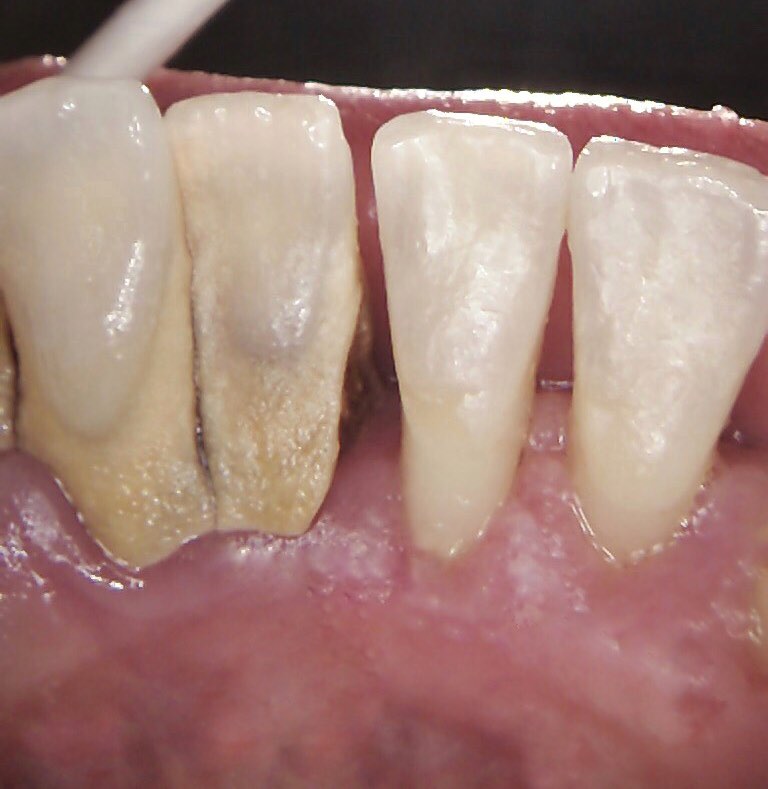

Calculus buildup cleaningin at dentist professional#
A professional cleaning usually involves using toothpaste with different flavors you can choose from. The brush makes a grinding noise, but the process does not hurt. Using a high powered electric brush, the dentist will apply the gritty toothpaste to the teeth to get an even deeper clean. Once the tartar is removed from the teeth, the professional will brush the patient’s teeth with a gritty toothpaste. Then, a water spray is used to wash the tartar away. Ultrasonic Instruments: When the dental professional uses ultrasonic instruments to remove tartar, the metal vibrating tip from the ultrasonic instrument loosens the tartar and helps chip it off the surface of the teeth.
Calculus buildup cleaningin at dentist manual#
When using the manual tools, the dentist will not be able to see the tartar, so they use their sense of touch to locate the areas that have the most tartar buildup.
:max_bytes(150000):strip_icc()/plaque-vs-tartar-5195721-FINAL-8d67ad474cb04ee6932f10e5047dd221.jpg)

Hand Held Manual Instruments: If this is the method used, the dental professional will use s dental scaler and a curette to remove tartar from the surface of the teeth. To perform a dental scaling, the dentist or dental hygienist will use either a hand held, manual instrument or may prefer an ultrasonic instrument. Untreated periodontitis can lead to tooth loss.This is why prompt treatment (scaling and root planing) is necessary. Plaque and tartar move into these spaces, leading to symptoms like: swollen/bleeding gums, loose teeth, bad breath, and pus. As the gums become more irritated, they separate from the teeth and deep spaces called periodontal pockets are formed. Dental plaque accumulates when you neglect oral hygiene. It’s a severe type of gum disease that can’t be reversed (only slowed down). If gingivitis is left untreated, periodontitis will develop with time. The procedure is recommended if you have periodontal disease (periodontitis). Root planing and scaling is a procedure that removes hardened tartar buildup in a non surgical method. If there is an excessive amount of tartar, the dentist or dental hygienist may recommend a deep cleaning that combines scaling and root planing. A scaler is a device that has a hook on the end of it, and it is used to remove tartar above and below the gum line. If the dentist or dental hygienist spots tartar on the surface of the teeth, they will remove it with an instrument called a scaler. The dentist will use a small mirror to check the teeth and the gums for any potential issues, tartar build up being one of them. How does a dentist remove tartar from the surface of teeth? Read further as we explain how the pros take tartar off teeth.Ī dental cleaning will start with a total examination of the entire inside of the mouth. At these checkups, your dentist can treat tartar build ups with a professional dental cleaning. To stay on top of and prevent tartar buildup, it is important to develop regular brushing and flossing habits, twice daily and see a dentist near you for biannual checkups. Fortunately, this type of gum disease is reversible with professional teeth cleanings in its early stages. Gingivitis (early gum disease) forms as a result. Bacteria accumulate and spread to the gums, causing inflammation. When minerals in the saliva combine with plaque it will form crystals that harden into tartar. Tartar deposits form when the plaque formation from the surface of teeth is not removed completely. Tartar, sometimes referred to as dental calculus, is a crusty film that can stain the teeth and cause discoloration. If you are interested in keeping up with good oral hygiene habits, getting rid of tartar from the surface of the teeth should be a top priority.


 0 kommentar(er)
0 kommentar(er)
